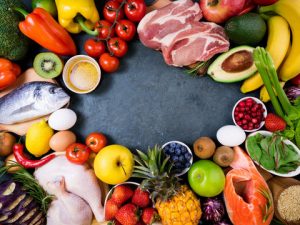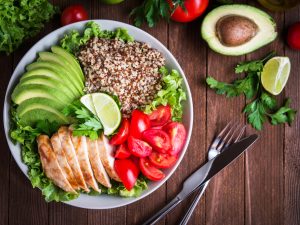The term “metabolism” was coined by the Prussian physiologist Theodor Schwann in the mid-nineteenth century, taking a Greek root and suffix: metabole (change) and ism (quality). In this way, Schwann conceptualized the quality of living beings to change or transform some substances through complex internal chemical processes.
How the metabolism works
Metabolism is how carbohydrates, proteins, fats, and other substances are transformed in the body. This transformation produces heat, carbon dioxide, water, and debris to produce energy to carry out essential chemical transformations for the body and develop the muscular activity.
Metabolic activity includes the absorption, transformation, and elimination of substances that allow cells to fulfill their energy or synthesis functions. This activity is composed of two phases.
Anabolism
It is a stage of the metabolic process in which ingested substances are transformed into new organic matter.
For example, protein synthesis in muscle tissue from amino acids.
Catabolism
It is a phase of the metabolic process in which energy is produced, and destructive chemical reactions are discarded.
For example, the breakdown of the glucose molecule that is transformed into energy and water.
The metabolic process is carried out thanks to the enzymes synthesized in the cells. While the thyroid glands and the liver act as regulators of the process. For this reason, a thyroid failure can lead to conditions such as hypo or hyperthyroidism, which often lead to metabolic problems (weight gain or loss).
While in the liver, glucose or sucrose is produced from carbohydrates, a fundamental substance for some organs that can only obtain energy from glucose and is the organ in which some proteins are synthesized.
Types of metabolism
The metabolic process can be of two types:
Aerobic metabolism
Aerobic metabolism involves obtaining energy from the combustion of carbohydrates in the presence of oxygen. This type of metabolic process is also known as lung respiration or oxidative metabolism.
Anaerobic metabolism
Anaerobic metabolism is carried out from the combustion of carbohydrates in the absence of oxygen to obtain energy. Glucose and glycogen in carbohydrates are not entirely degraded, as they require oxygen to do so, which is why they are transformed into lactic acid in humans.
Fat in metabolism
Fats are concentrated energy sources. They produce twice as much energy as carbohydrates or protein on a weight basis.
The functions of fats include:
Helps to form cell structure;
Formation of a protective cushion and insulation around the vital organs;
Helping absorb fat-soluble vitamins,
Offer reserve storage for energyEssential fatty acids include unsaturated fatty acids like linoleic, linolenic, and arachidonic acids. These need to be taken in diet. Saturated fats, along with cholesterol, have been implicated in arteriosclerosis and heart disease.
Minerals and vitamins in metabolism
Minerals in foods do not directly contribute to energy needs but are essential as regulators of the body and do not play a role in the body’s metabolic pathways. More than 50 elements are found in the human body. About 25 elements are essential, meaning that a deficiency produces specific symptoms of the deficiency.
Important minerals include:
Calcium
Match
Iron
Sodium
Potassium
Chloride ions
Copper
Cobalt
Manganese
Zinc
Magnesium
Fluorine
IodineVitamins are essential organic compositions that the human body cannot synthesize on its own and must therefore be present in the diet. Vitamins essential in metabolism include:
Vitamin A
B2 (riboflavin)
Niacin or nicotinic acid
Pantothenic acidThe chemical reactions of metabolism are arranged in metabolic pathways. These allow the primary chemicals of nutrition to be transformed through a series of steps into another chemical by enzymes.
Enzymes are crucial to metabolism because they allow organisms to drive desirable energy-requiring reactions. These reactions are also coupled with those that release energy. At the same time, enzymes act while catalysts; allow them to proceed with these reactions quickly and efficiently. Enzymes also regulate metabolic pathways in response to changes in the cell environment or signals from other cells.
First, metabolism is the process your body uses to convert the food you eat into the energy it needs. It is a vital process for all living beings, not only for humans, the energy that our body obtains when we eat, like Popeye when he took spinach. However, given the myths that are running lately about this process, nutritionist Nancy Farrell has decided to make things clear in ‘Health.’ How much is truth, and how much legend?
The slim and metabolism
REALITY. We already have the preconceived idea that skinny people have accelerated metabolism. Is it true? “More than body size, we should talk about composition,” explains Nancy. “I mean by this, and it doesn’t have to do with how thin you are but with how much muscle you have in your body. Muscle is more metabolically active.”
Metabolism is a vital process of all living beings, but a series of myths and legends have arisen that must be clarified.
“So lifting weights is one of the best ways to speed it up,” she explains. “The more muscle you have, the more calories you burn, although many people make the mistake of focusing solely on cardio.” What is not true is that you can eat whatever you want because you have a fast metabolism.
Metabolism is genetic
MYTH. By thinking that it is genetic, we believe that it cannot be changed. Your genes play a role, of course, but they don’t affect as much as your habits and lifestyle, according to Farrell. The exercise you do and what you eat are vital factors, but, indeed, some inherited conditions such as Hashimoto’s disease (a relatively joint inflammation of the thyroid gland) can cause you to gain weight.






























Add Comment